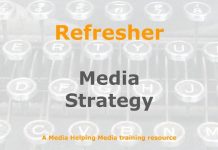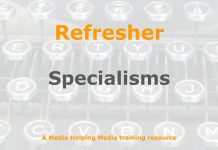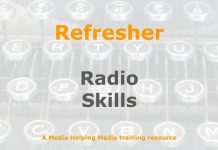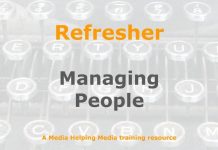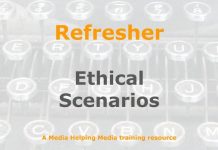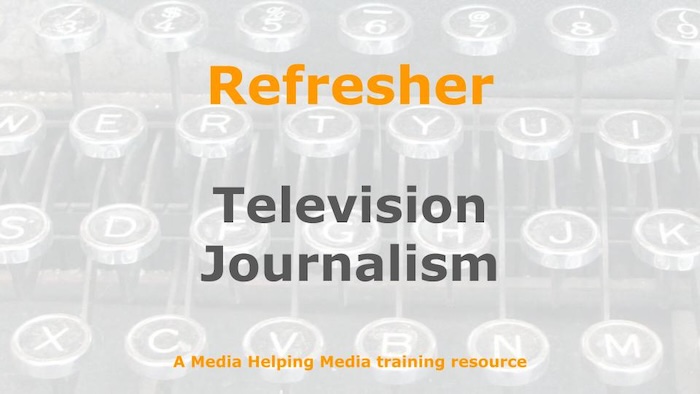 This comprehensive one-day intensive training course is designed to provide journalists with the foundational and advanced techniques necessary for producing compelling broadcast content, from news packages to documentaries.
This comprehensive one-day intensive training course is designed to provide journalists with the foundational and advanced techniques necessary for producing compelling broadcast content, from news packages to documentaries.
Drawing directly from the structured material available in our six-week Module: TV journalism skills, this course focuses on the core elements of visual storytelling, scriptwriting for the screen, effective interviewing, and maintaining high ethical standards in a video environment.
Over the course of the day, participants will engage with the essential workflow of TV news production, learning how to combine visuals, audio, and narration into cohesive packages.
The training will cover the critical roles of the news producer and the ethical responsibilities associated with photojournalism and visual integrity.
Through practical exercises and analysis of case studies, attendees will be prepared for the demands and ethical challenges of a modern broadcast newsroom.
The programme is structured into four intensive sessions, building progressively from foundational package construction to long-form production and ethical decision-making.
We recommend that participants read the resources listed below before attending this refresher.
Session 1: Constructing the tv news package (09:00 – 10:45)
- Focus: The structure, planning, and essential elements required to create a compelling TV news package.
- Learning how to combine visuals (video), interviews (sound bites), voice-overs, and stand-ups.
- The basics of planning, gathering footage, scripting, and editing.
- The importance of news values and editorial decision-making in the package workflow.
- Group activities:
- Package analysis: Participants analyse sample TV news packages, identifying the key structural elements (open, voice-over, sound bites, close) and discussing their effectiveness.
- Outline exercise: Groups outline the visual and narrative components of a TV news package based on a current event brief.
- Recommended session resources:
10:45 – 11:00: Break
Session 2: Visual storytelling and interviewing for television (11:00 – 12:45)
- Focus: Scriptwriting techniques for television, prioritising visuals, and conducting effective on-camera interviews.
- The craft of writing concise, clear, and engaging scripts that complement the visuals (letting the pictures tell the story).
- Techniques for scripting around pictures and effectively using natural sound (nat sound).
- Preparation, questioning techniques, framing shots, and eliciting strong, newsworthy on-camera responses.
- Group activities:
- Scripting challenge: Participants are given a short, silent video clip and tasked with writing a 30-second voice-over script, focusing on complementary text rather than redundancy.
- Interview role-play: Pairs practise conducting mock interviews, focusing on subject placement, framing, and generating usable sound bites.
- Recommended session resources:
12:45 – 13:45: Lunch
Session 3: News production management and brand values (13:45 – 15:30)
- Focus: Understanding the newsroom environment, the role of the TV news producer, and maintaining organisational brand values.
- The core responsibilities of the news producer, including team management, editorial decision-making, and programme oversight.
- Ensuring news output reflects the station’s identity, values, and maintains consistency, trust, and credibility.
- The relationship between production decisions and ethical considerations in the day-to-day news cycle.
- Group activities:
- Producer’s challenge: Groups are given a scenario (e.g., a breaking story with limited resources) and must make rapid editorial and logistical decisions, justifying their choices based on news values and brand identity.
- Brand audit: Participants analyse the news output of two different broadcasters to discuss how each reflects distinct brand values and journalistic identities.
- Recommended session resources:
15:30 – 15:45: Break
Session 4: Long-form production and visual ethics (15:45 – 17:30)
- Focus: Creating in-depth documentaries and current affairs programmes, and addressing the ethical responsibilities of visual journalism.
- The process of long-form storytelling: topic selection, research, narrative structure, and the differences from news packages.
- Planning, filming, scripting, and editing stages for documentaries, including legal and ethical considerations in investigative work.
- Examining the ethical responsibilities of photojournalism and the use of images, including consent, privacy, and avoiding manipulation.
- Group activities:
- Documentary pitch: Individuals pitch a concept for a TV documentary or current affairs feature, outlining the narrative arc and potential ethical challenges.
- Ethical dilemma case studies: Groups analyse real-world scenarios concerning informed consent, privacy protection, and the use of potentially offensive or traumatic images, discussing the most responsible course of action.
- Recommended session resources:
17:30: Course end and wrap-up
A recap and discussion on what has been learnt.
Related material
